Kurosawa had wanted to do a film like Yojimbo for a long time. A story not of good vs. evil, but of evil vs. evil with a hero stepping in and wiping out both sides. He finally settled on a story clearly inspired by Dashiell Hammet’s Red Harvest and The Glass Key. Since Kurosawa now had his own production company, there wasn’t anyone to say no to him at this point, and he was able to bring a long gestating project off the ground.
The result was in many ways his most successful film, critically and financially.
Yojimbo wastes no time. During the credits, we follow an unnamed samurai (Toshiro Mifune) as he wanders down a dusty road. He looks disreputable. He reaches a crossroad and he throws a stick up in the air to decide where chance will lead him. Without saying a word, Kurosawa establishes that we’re watching the exploits of a ronin. And we’re traveling with him on a journey to his next adventure.
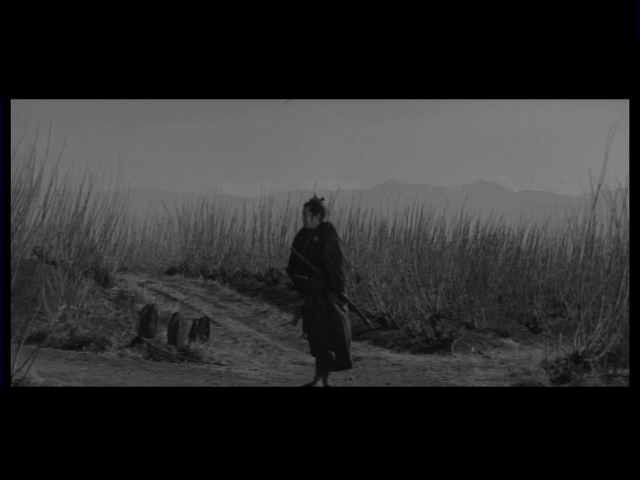
And that’s about all we’ll ever know about this samurai with no name. This doesn’t mean he’ll be without character, only that the film never blatantly spells out his history. The character is interesting as we watch him and his actions, not because we’re supposed to relate, but simply through the sheer magnetism of Mifune’s performance and the sense that he’s doing something intrinsically interesting.
Mifune stops briefly to get a drink of water at a farm. He overhears a family quarrel. Apparently there’s trouble in the town ahead and they’re shelling out good money for swords. The son wants to leave and get ahold of that money over the objections of his mother and father. But the son would rather live a short, exciting life than a dull, long one. Or, at least, he thinks that’s what he wants.
It’s not long before Mifune wanders into the nearby town, complete with dust blowing in the streets. Fearful people look out from behind shuttered windows. It’s a classic western setup, yet at the same time no western has ever really opened this way. An old form is given new life.
But the town is in trouble and Kurosawa neatly summarizes it in one image. A dog comes trotting down the street with a severed hand in its mouth.

The unnamed ronin, and the audience, soon gets a dose of exposition from the local constable Hansuke (Ikio Sawamura) who shows his corruption by not trying to end the fighting, but instead is profiting by making referrals of swordsmen to the various sides. This ronin looks like a prime candidate to be a bodyguard (yojimbo). There’s a fight for territory going on between Seibei (Seizaburo Kawazu), the older town gang lord, and his former right hand man Ushitora (Kyu Sazanka), who has been passed over in succession in favor of Seibei’s son, Yoichiro (Hiroshi Tachikawa). The older mayor and silk merchant Tazaemon (Kamatari Fujiwara) backs Seibei and bangs on his prayer drum all day. The sake brewer Tokuemon (Takashi Shimura) backs Ushitora. No side is winning and all the feud is doing is terrorizing the populace. And filling the coffers of the coffin maker.
Kurosawa wisely splits the exposition between Hansuke and Gonji (Eijiro Tono), the local restaurant owner who just wants peace and quiet. And Kurosawa keeps the exposition visually dynamic by having Gonji open and close windows as he points out the various details of the town feud. It’s to Kurosawa’s credit as a filmmaker that he lays out the various sides and factions clearly, so that when the plot machinations start the audience gets to enjoy the plot turns rather than be confused by them.
Perhaps because he’s bored, or perhaps because it offends his sense of right and wrong, the ronin instantly decides to do something about it. Much to the disbelirf of Gonji. he decides to destroy both sides.
And then the fun begins. Mifune picks a fight with three of Ushitora’s men and wipes them out in a blaze of swordplay. One of the bandits has his arm lopped off, presaging a shot that George Lucas will use in the cantina fight in Star Wars. Mifune walks away, and nonchalantly tells the coffin maker “Two coffins. No, maybe three.” A line Clint Eastwood will get to put his own spin on in his star making role in A Fistful of Dollars.
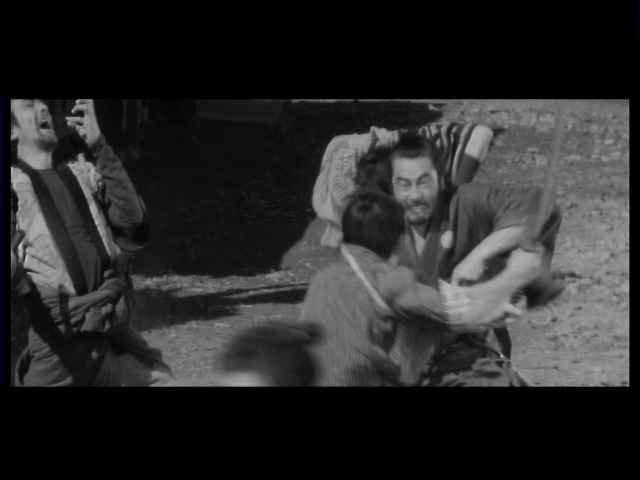
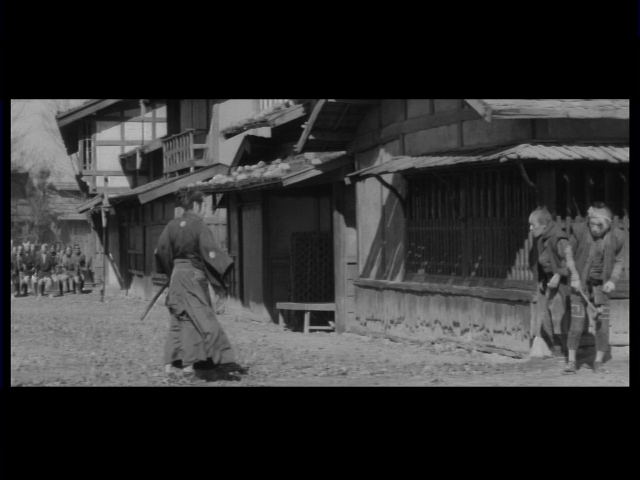
After demonstrating his prowess, Mifune goes to Seibei and offers his services to him for an exorbitant price. Seibei’s sword master Homma (Susumu Fujita) seems unimpressed with the ronin (perhaps a fun play on Mifune being Fujita’s replacement as Kurosawa’s younger leading man), but that’s ok because the ronin is equally unimpressed. It’s at this point that Mifune is asked to give his name, and while looking out at a mulberry field, emphasized through an axial cut, responds “Kuwabatake Sanjuro” (which translates as “mulberry field thirty-year-old”) with the proviso that closer to forty would be more accurate. Nor does Sanjuro take pains to hide that the name is made up, his real name would be meaningless anyways. He truly is a man with no name.
After formal introductions are out of the way, the first series of betrayals is at hand. Seibei’s wife Orin (Isuzu Yamada, ever the Lady MacBeth figure from Throne of Blood and The Lower Depths) immediately schemes to have Sanjuro murdered after the climactic battle. It would be chilling if Sanjuro wasn’t already on to their schemes and listening in, even letting the geisha girls know that he knows what’s up. Instead the scheme becomes ridiculous. And Sanjuro wastes no time setting up the climactic battle for high noon, while Homma bails on the whole enterprise, perhaps because he feels underpaid / perhaps out of cowardice.
Both sides gather in the streets. Sanjuro publicly bails on Seibei, tossing down his payment and taking a spectator’s seat in a tower overlooking the center of town. No side can back down without losing face, and this evenly matched brawl is almost certainly going to essentially wipe out both sides. Everyone knows it, including Sanjuro, who literally sits above them all and takes much amusement in watching the two sides timidly approach each other. As a first act, it’s a masterpiece and Kurosawa could have ended on Sanjuro’s smile for a satisfying short film.
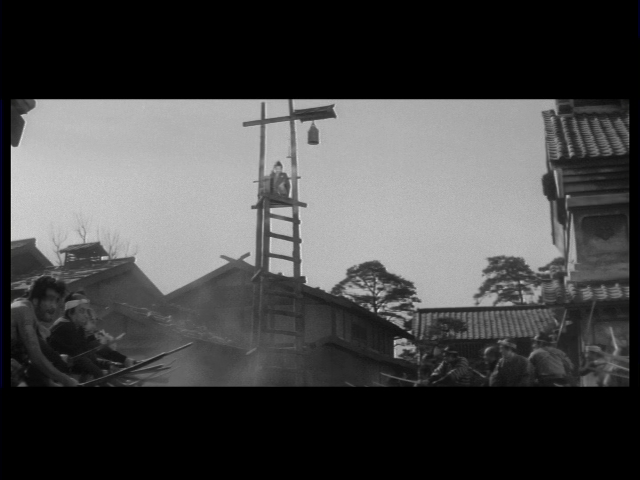
But, there’s a lot more to the film and just as the clash looks like it will begin, it’s interrupted by news that a Shogun official is coming. And the hypocrisy of both sides is exposed as an immediate truce is called.

Kurosawa, unlike in The Bad Sleep Well, takes a comical look at the government officials. It’s a background drama as Sanjuro and Gonji watch them being bribed quite blatantly, with much pomp and circumstance. Kurosawa plays it as a ritual and an absurd, blatantly obvious ritual it is.
If there’s a real criticism to be made of Yojimbo, it’s of repetition. Throughout much of the second act the first act is repeated; Sanjuro brings the two sides to the precipice of a final clash, only for outside forces to intervene and prolong the conflict. In the hands of a lesser filmmaker, it could become annoying. In the hands of Kurosawa it becomes something of a running joke and it’s immensely entertaining to watch unfold.
There’s an immediate bidding for Sanjuro’s services during the truce. Both sides make offers and Sanjuro is content to take their drinks. But, the truce can’t stand for too long, and Ushitora pushes the action by getting the government inspector out of town due to a murder of an officer in another town. An assassination that will happen later that night, so nobody misses the message of the lengths that Ushitora is willing to go.
Kurosawa throws in the main complication as Ushitora’s younger brother Unosuke (Tatsuya Nakadai). Nakadai literally had a walk on role in Seven Samurai, but would come to be one of Kurosawa’s main leading men, reaching his zenith with the one two punch of Kagemusha and Ran. Kurosawa establishes right away that Unosuke is smart. Vain too. But dangerous as a snake, even to Sanjuro as Unosuke carries with him a pistol, and a sword vs. a pistol is an unfair advantage. Suddenly Sanjuro is not so invulnerable as his sword mastery would seem to make him and he has a worthy nemesis.
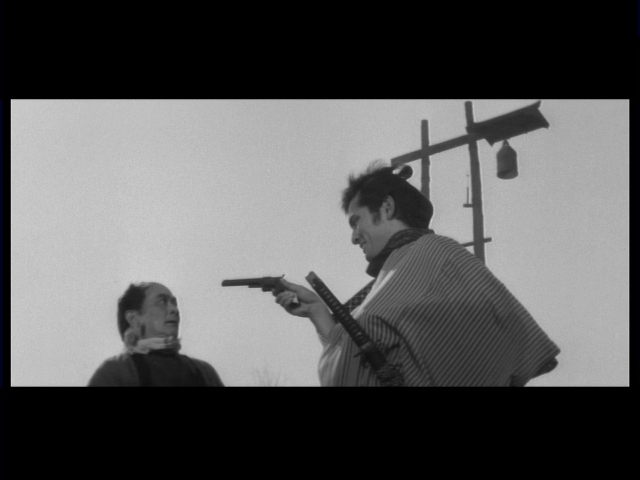
Still, Sanjuro is apparently undaunted about his plan despite this newest complication. Both sides are willing to wait out the truce through the silk fair, there’s money to be made after all and they can wait until afterwards for their feud to resume, no doubt bigger than ever. Neither side is willing to pay their men for nothing, and that cheapness gives Sanjuro an opportunity. The men that carried out the assassination get drunk and are none too pleased about their pay. Sanjuro makes sure that they never arrive wherever they intended to go and delivers them into the arms of Seibei, giving Seibei the power to turn them over to the Shogun and destroy Ushitora in one stroke.
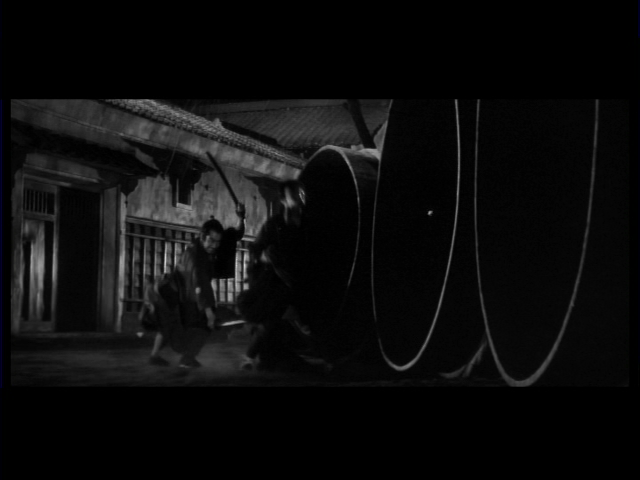
That is, if Ushitora didn’t get word of the hostages from Sanjuro. And Sanjuro didn’t get a rich reward from both sides for his efforts. But, instead of an all out, desperate assault, Unosuke goes out and captures Yoichiro and a hostage exchange is soon arranged.
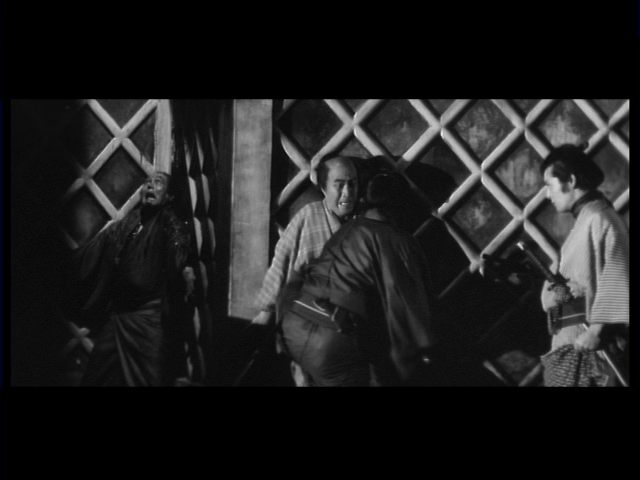
Unosuke shows that he’s not someone to be trifled with as the hostage exchange turns into an opportunity for Unosuke to gun down the killers and forever assure their silence, without giving up Yoichiro. But, Yojimbo isn’t a film that goes long without a double cross and it turns out that Seibei has captured a woman that Tokuemon is keeping for himself as collateral from a wager. Tokuemon’s part of the money behind Unosuke and his support is necessary, so a real exchange is arranged.
It’s during the latter exchange where the film shifts gears. Up to now, it’s been a black comedy where the bad get their comeuppance from Sanjuro but no great evil is taking place. During the exchange, the woman breaks away to her husband and son and we get to see a real cost to the gangsters. A woman is separated from her husband and child and she’s repeatedly raped all because of the corrupt powers of the town. Even though the exchange has some comic moments, Sanjuro quits laughing and is clearly bothered by the powers that he’s not destroying as fast as he envisioned. Not that the scene is dour, Yoichiro is greeted by a series of slaps from his mother, but the film starts to build to something a little more serious.


Sanjuro has been fooling around having fun for his amusement and enrichment. And, as he hears of the misery of others, he does what every Kurosawa hero does, he takes action. He throws in as the bodyguard to Ushitora. And he takes Ushitora’s dimwitted brother Inokichi (Daisuke Kato) to check in on the woman out of concern for her security. When Sanjuro arrives, he uses Inokichi’s stupidity, first by sending Inokichi away to beat the husband, and then by rushing back to inform Inokichi that the guards are all dead and the woman missing, and sending him back for reinforcements.
Of course, the guards aren’t dead. For a little bit, as Sanjuro dispatches them in another spectacular action scene, frees the woman, gives her money, and tells the whole family to flee and never come back. He then proceeds to make the the place where they imprisoned the woman look like a war zone, not the precise work of a master swordsman. Only to come out to see that the family hasn’t fled, but instead wants to give him thanks, which is the last thing he needs or wants. Especially with Ushitora’s armed guards rapidly approaching. It’s the approaching guards that finally get the family moving.

The results are all that Sanjuro could hope for as hostilities immediately resume and escalate. The silk warehouse is burned and the sake brewery is vandalized, essentially robbing both sides of revenue. Neither side can find the woman and her family, which drives up their desperation. Both sides are devastated in the fighting and bodies litter the windswept streets. Everything is apparently going according to plan.
But, no good deed goes unpunished. A thank you note is delivered to Gonji for Sanjuro’s good deed. Sanjuro has no use for it and leaves it lying on the table, in plain sight. That’s when Unosuke and Inokichi arrive with news that the woman and her family have been seen running free. If Seibei didn’t free her, then who did? The only true free agent in town is Sanjuro. And neither Sanjuro nor Gonji are nimble enough to stop Unosuke from discovering the incriminating note.
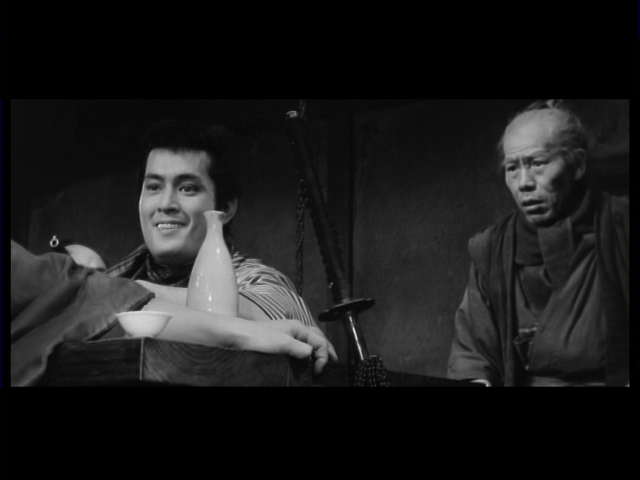
The only thing that keeps Sanjuro alive at this point is the idea that he might know where the woman is hiding. He doesn’t, but he’s not going to spoil his one trump card despite taking a terrible beating. Kurosawa doesn’t hold back on making it look like Sanjuro is on the verge of death. But, he’s still clever and manages to escape, by hiding to make it look like he’s already escaped so that all doors are thrown open in a search for him.
Sanjuro will make his way to Gonji’s place, where Gonji will hide him. Plans are made to smuggle Sanjuro out of town in a coffin. But, in the confusion, Ushitora strikes at Seibei’s place, burning them out with Unosuke gunning down Yoichiro, Orin, and Seibei even after they’ve surrendered. But, they fail to find Sanjuro, and Gonji even cons Inokichi to help him carry the coffin out of town to the graveyard.
It’s there that Sanjuro emerges from the coffin, looking like a ghost / demon from hell. A fitting image as he will have unfinished business to attend to after he recovers.

It’s not long before the big showdown. Gonji is captured trying to smuggle food to the ronin and tortured for that information. Sanjuro owes a debt which he doesn’t hesitate to repay when informed of the news, and he doesn’t hesitate to commence the climactic duel.
The showdown is a total triumph for Kurosawa. Mifune strikes a larger than life figure in the wind blown streets. A duel of sword vs. pistol doesn’t get any more symbolic. History comes down on the side of the pistol, but Kurosawa comes down on the side of the sword and throwing knife, as Sanjuro wipes them all out in a brilliant blaze of swordplay. It’s cinematic mythmaking at its best.
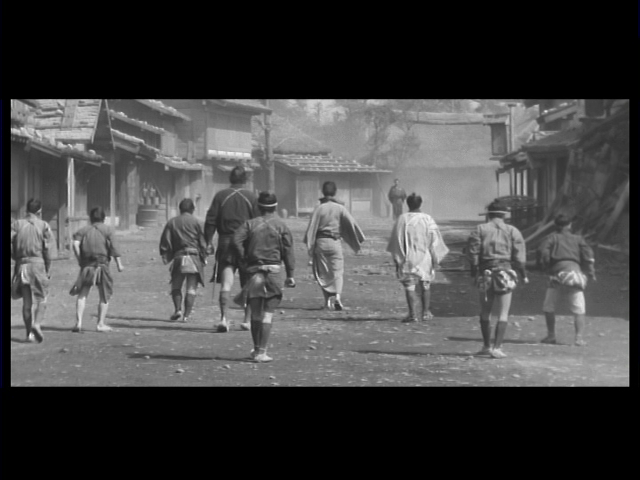
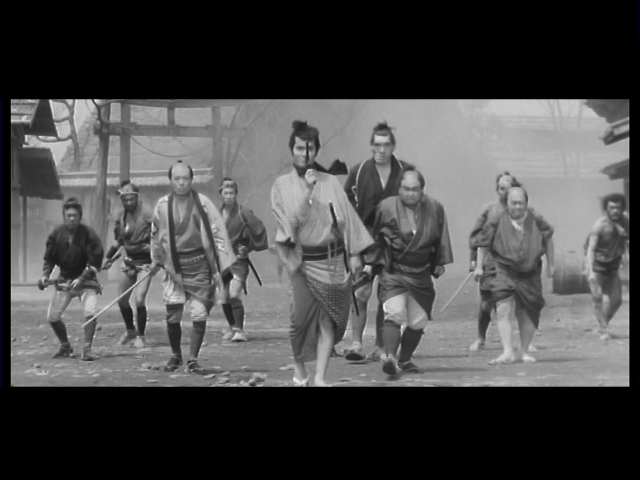
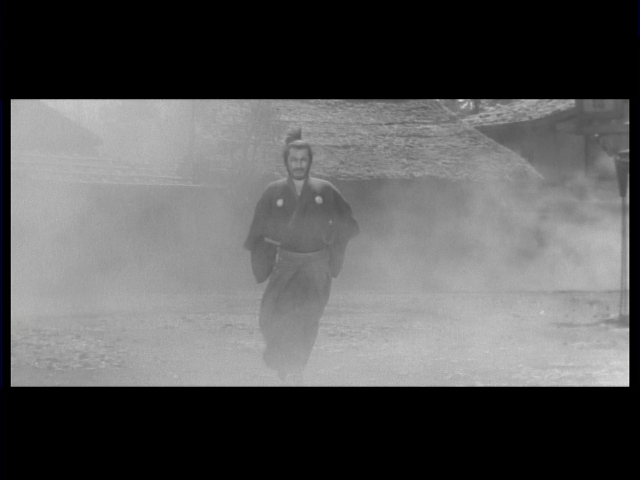
Words don’t do justice to the climax of Yojimbo which is one of Kurosawa’s finest action achievements. The sequence is pure cinematic joy. It’s a climactic duel that set the standards and has provided endless variation since.
Kurosawa manages to bring the film full circle as well, as Sanjuro spares the life of the farmer’s son who ran off in the beginning of the movie with the advice that a long, boring life is the best life. Kurosawa always liked to have messages in his movies, but the fact that it’s addressed in such an offhand manner is a testament to the pure joy found in the rest of the movie as cliché after cliché is demolished.
Even the ending is mythic. Sanjuro wastes little time after the last man is dead. There’s no peace or settling down for him, he unsuited to civilization. He says so long, and walks out of town, no doubt to his next adventure.
Yojimbo occupies a special place in my appreciation of Kurosawa as it’s the first Kurosawa film I ever saw in full. Even now, after spending countless hours with the majority of Kurosawa’s films, I can’t think of a better introduction. Countless others apparently agree as Yojimbo was an enormous success, critically and financially. Toshiro Mifune won several awards internationally for his performance, one of his all time greats, and it took no time at all for other filmmakers to take note as Sergio Leone started work shortly on A Fistful of Dollars, and the spaghetti western and much of the modern western, including Unforgiven, was born. The western isn’t the only genre that’s been impacted, as certainly Last Man Standing and Miller’s Crossing both bear the influence. It’s been a remarkably pliant blueprint for film and no doubt will keep influencing filmmakers for years to come.
Yojimbo was so successful, that even Kurosawa got caught up into making a sequel immediately. The first sequel Kurosawa attempted since Sanshiro Sugata, Part 2 and the only one of his own instigation. We’ll catch up to the continuing adventures of Sanjuro in our next installment.
There will be a brief pause for a few months while I stockpile some reviews, but I’m looking forward to the last year of the series when we’ll get through the final ten films of Kurosawa’s illustrious career, including his turn to color filmmaking. There are triumphs to be visited and I look forward to sharing them with the readers of this feature.
Next Time: SANJURO (1962)